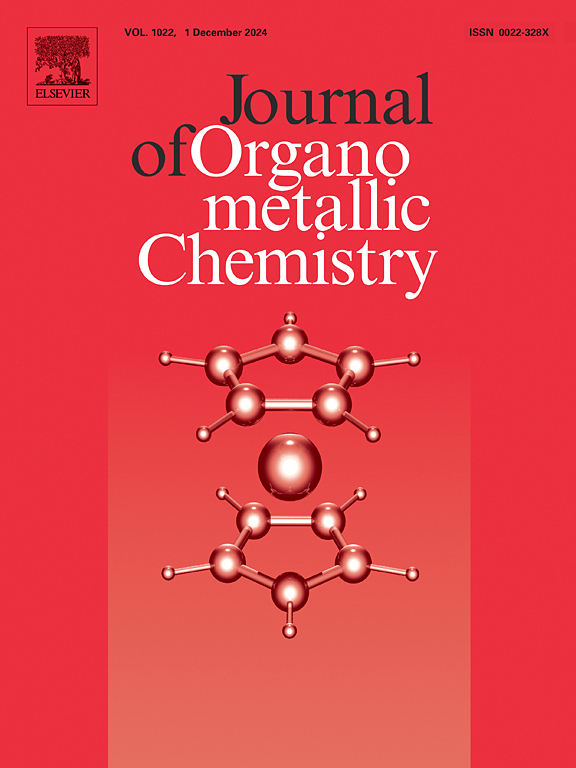磁性氧化铁纳米颗粒支撑钯纳米颗粒作为碳-碳Ullman均偶联反应和治疗人骨肉瘤的有效纳米催化剂
IF 2.1
3区 化学
Q3 CHEMISTRY, INORGANIC & NUCLEAR
引用次数: 0
摘要
以石榴皮提取物为稳定还原剂,在磁性Fe3O4纳米颗粒上降解钯纳米粒子。利用FE-SEM, EDX, TEM和ICP-OES等先进技术对纳米催化剂进行了广泛的表征。研究了Pd/Fe3O4纳米催化剂在乌尔曼均偶联法合成大范围双芳基化合物中的催化性能。除氯芳烃和位阻底物外,其余反应均取得了较好的效果。通过热过滤试验确定了催化剂的稳健性和非均质性,可连续重复使用8次,活性无明显损失。Pd/Fe3O4磁铁矿纳米颗粒导致骨肉瘤细胞活力下降。Pd/Fe3O4纳米复合材料对细胞系CADO-ES1、MHH-ES1和HOS的IC50值分别为117、175和112µg/mL。采用DPPH法检测Pd/Fe3O4纳米复合材料的抗氧化活性。IC50值表明Pd/Fe3O4纳米复合材料具有较强的抗氧化活性。最近的纳米颗粒技术似乎具有抗人骨肉瘤的特性,因为它的抗氧化特性。本文章由计算机程序翻译,如有差异,请以英文原文为准。

Palladium nanoparticles supported over the magnetic iron oxide nanoparticles as an efficient nanocatalyst for carbon-carbon Ullman homocoupling reactions and treatment of human steosarcoma
Palladium (Pd) nanoparticles decoated over the magnetic Fe3O4 nanoparticles, mediated by Pomegranate peel extract as stabilizing and reducing agent. The resulting nanocatalyst was extensively characterized using various advanced techniques, including FE-SEM, EDX, TEM and ICP-OES. The catalytic performance of the Pd/Fe3O4 nanocatalyst was investigated in the synthesis of wide range of biaryls following Ullmann homocoupling method. In all the reactions outstanding results were obtained except for chloroarenes and the sterically hindered substrates. The catalyst robustness and heterogeneity was determined by hot filtration test and it could be reused for 8 successive cycles without any significant loss in activity. Pd/Fe3O4 magnetite nanoparticles caused a decrease in the osteosarcoma cells viability. Pd/Fe3O4 nanocomposite' IC50 values against the cell lines CADO-ES1, MHH-ES1, and HOS were 117, 175, and 112 µg/mL, respectively. Pd/Fe3O4 nanocomposite' antioxidant activity was checked using the DPPH examination. The IC50 value indicated that the Pd/Fe3O4 nanocomposite exhibited considerable antioxidant activity. Recent nanoparticles technology appears to have anti-human osteosarcoma properties because of its antioxidant properties.
求助全文
通过发布文献求助,成功后即可免费获取论文全文。
去求助
来源期刊

Journal of Organometallic Chemistry
化学-无机化学与核化学
CiteScore
4.40
自引率
8.70%
发文量
221
审稿时长
36 days
期刊介绍:
The Journal of Organometallic Chemistry targets original papers dealing with theoretical aspects, structural chemistry, synthesis, physical and chemical properties (including reaction mechanisms), and practical applications of organometallic compounds.
Organometallic compounds are defined as compounds that contain metal - carbon bonds. The term metal includes all alkali and alkaline earth metals, all transition metals and the lanthanides and actinides in the Periodic Table. Metalloids including the elements in Group 13 and the heavier members of the Groups 14 - 16 are also included. The term chemistry includes syntheses, characterizations and reaction chemistry of all such compounds. Research reports based on use of organometallic complexes in bioorganometallic chemistry, medicine, material sciences, homogeneous catalysis and energy conversion are also welcome.
The scope of the journal has been enlarged to encompass important research on organometallic complexes in bioorganometallic chemistry and material sciences, and of heavier main group elements in organometallic chemistry. The journal also publishes review articles, short communications and notes.
 求助内容:
求助内容: 应助结果提醒方式:
应助结果提醒方式:


